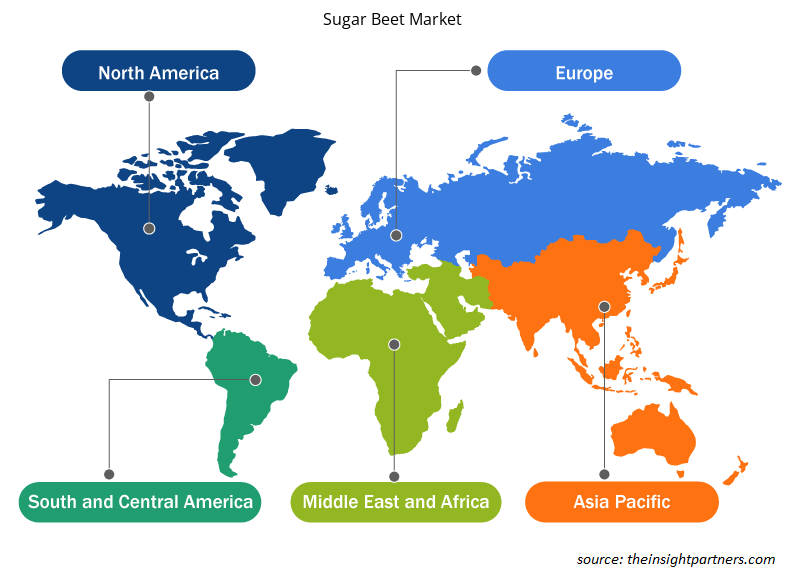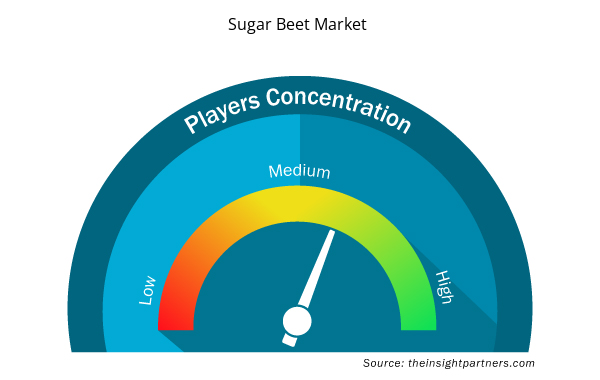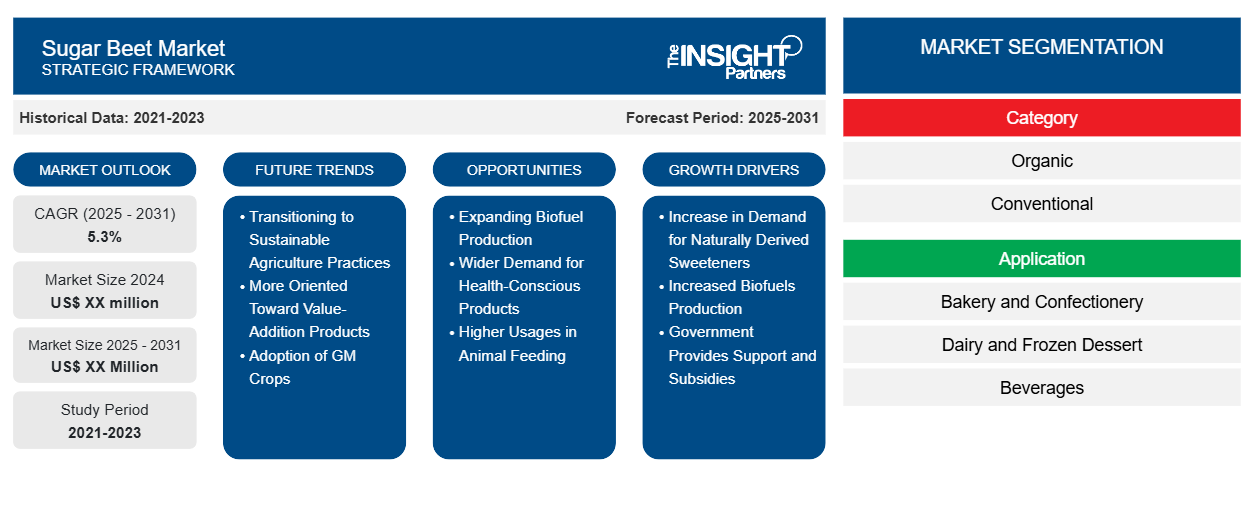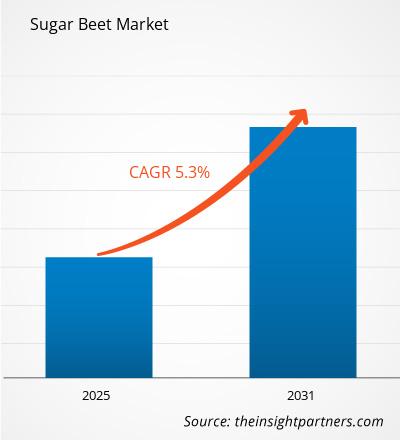The Sugar Beet Market is expected to register a CAGR of 5.3% from 2023 to 2031, with a market size expanding from US$ XX million in 2023 to US$ XX Million by 2031.
The report is segmented by category (organic, conventional). The report further presents analysis based on application (bakery and confectionery, dairy and frozen dessert, beverages, others). The global analysis is further broken-down at regional level and major countries. The Report Offers the Value in USD for the above analysis and segments.
Purpose of the Report
The report Sugar Beet Market by The Insight Partners aims to describe the present landscape and future growth, top driving factors, challenges, and opportunities. This will provide insights to various business stakeholders, such as:
- Technology Providers/Manufacturers: To understand the evolving market dynamics and know the potential growth opportunities, enabling them to make informed strategic decisions.
- Investors: To conduct a comprehensive trend analysis regarding the market growth rate, market financial projections, and opportunities that exist across the value chain.
- Regulatory bodies: To regulate policies and police activities in the market with the aim of minimizing abuse, preserving investor trust and confidence, and upholding the integrity and stability of the market.
Sugar Beet Market Segmentation
Category
- Organic
- Conventional
Application
- Bakery and Confectionery
- Dairy and Frozen Dessert
- Beverages
- Others
Customize This Report To Suit Your Requirement
You will get customization on any report - free of charge - including parts of this report, or country-level analysis, Excel Data pack, as well as avail great offers and discounts for start-ups & universities
- Get Top Key Market Trends of this report.This FREE sample will include data analysis, ranging from market trends to estimates and forecasts.
Sugar Beet Market Growth Drivers
- Increase in Demand for Naturally Derived Sweeteners: Shifting away from unhealthy sugary refined forms, consumers are now inclined toward using sweeteners that are naturally derived. Thus, the sugar beet market is flourishing as sugar beets are a primary source of natural sugar; people are now preferring sugar beets more for its healthier and environmentally friendly sweetener form in foods and beverages.
- Increased Biofuels Production: It also increases sugar beets because they can be converted to biofuels. Sugar beets are consumed more and more into bioethanol production because the increase in the demand for renewable energy results in the growth of biofuels industry, in accordance with the actions of countries moving towards global sustainability processes.
- Government Provides Support and Subsidies: Most regions, including Europe and North America, have government policies and subsidies in support of the sugar beet industry. These benefits to farmers will encourage the production of sugar beets, leading to an enhanced stability of supply so that sugar can be produced for various industries-from food manufacturing to biofuels.
Sugar Beet Market Future Trends
- Transitioning to Sustainable Agriculture Practices: The sugar beet industry is undergoing transformation with sustainable agriculture practices. Farmers are shifting to an eco-friendly method of precision farming, using lesser pesticides, and practicing crop rotation, thus minimizing their environmental footprint as well as improving soil health, in tune with global sustainability drive.
- More Oriented Toward Value-Addition Products: There is increasing progress in value-addition between the markets of sugar beet for bioplastic and bioethanol, derived from the sugar beet plant. The shift in converting sugar beet to renewable sources results in the further diversification of sugar beet usage beyond sugar to the use of eco-friendly materials, all supporting green innovation.
- Adoption of GM Crops: Increasingly, genetically modified (GM) sugar beet has been introduced into the market; pest and disease resistant plus high-yielding crops are being adopted under this trend in the sugar beet market. The desirability of this way increases productivity in sugar manufacturing, while addressing environmental challenges and enforcing better crop resilience.
Sugar Beet Market Opportunities
- Expanding Biofuel Production: Here, in terms of the bioethanol production, it offers opportunity for sugar beet as a renewable energy source. Governments are increasingly propagating cleaner energies-the biofuels from sugarbeet can thus help in carbon mitigation and energy sustainability.
- Wider Demand for Health-Conscious Products: Natural sweetness of sugar beets and low glyemix index can provide opportunity for healthier alternatives to refined sugar: with rising consumer health consciousness, there is potential for development in sugarbeet sweeteners and healthier marketed food products.
- Higher Usages in Animal Feeding: Sugar beet pulp is interesting stuff in animal nutrition and it is a residue available after sugar extraction. It is a great opportunity to capture the future demand for healthier and economical animal feeds:-the growing livestock industry especially in regions concerned with sustainable farming flocks are increasing in number.
Sugar Beet Market Regional Insights
The regional trends and factors influencing the Sugar Beet Market throughout the forecast period have been thoroughly explained by the analysts at Insight Partners. This section also discusses Sugar Beet Market segments and geography across North America, Europe, Asia Pacific, Middle East and Africa, and South and Central America.

- Get the Regional Specific Data for Sugar Beet Market
Sugar Beet Market Report Scope
| Report Attribute | Details |
|---|---|
| Market size in 2023 | US$ XX million |
| Market Size by 2031 | US$ XX Million |
| Global CAGR (2023 - 2031) | 5.3% |
| Historical Data | 2021-2022 |
| Forecast period | 2024-2031 |
| Segments Covered | By Category
|
| Regions and Countries Covered | North America
|
| Market leaders and key company profiles |
|
Sugar Beet Market Players Density: Understanding Its Impact on Business Dynamics
The Sugar Beet Market market is growing rapidly, driven by increasing end-user demand due to factors such as evolving consumer preferences, technological advancements, and greater awareness of the product's benefits. As demand rises, businesses are expanding their offerings, innovating to meet consumer needs, and capitalizing on emerging trends, which further fuels market growth.
Market players density refers to the distribution of firms or companies operating within a particular market or industry. It indicates how many competitors (market players) are present in a given market space relative to its size or total market value.
Major Companies operating in the Sugar Beet Market are:
- Agrana Zucker
- Amalgamated Sugar
- American Crystal Sugar Company
- British Sugar Plc
- Michigan Sugar Company
Disclaimer: The companies listed above are not ranked in any particular order.

- Get the Sugar Beet Market top key players overview
Key Selling Points
- Comprehensive Coverage: The report comprehensively covers the analysis of products, services, types, and end users of the Sugar Beet Market, providing a holistic landscape.
- Expert Analysis: The report is compiled based on the in-depth understanding of industry experts and analysts.
- Up-to-date Information: The report assures business relevance due to its coverage of recent information and data trends.
- Customization Options: This report can be customized to cater to specific client requirements and suit the business strategies aptly.
The research report on the Sugar Beet Market can, therefore, help spearhead the trail of decoding and understanding the industry scenario and growth prospects. Although there can be a few valid concerns, the overall benefits of this report tend to outweigh the disadvantages.
- Analyse historique (2 ans), année de base, prévision (7 ans) avec TCAC
- Analyse PEST et SWO
- Taille du marché Valeur / Volume - Mondial, Régional, Pays
- Industrie et paysage concurrentiel
- Ensemble de données Excel



Report Coverage
Revenue forecast, Company Analysis, Industry landscape, Growth factors, and Trends

Segment Covered
This text is related
to segments covered.

Regional Scope
North America, Europe, Asia Pacific, Middle East & Africa, South & Central America

Country Scope
This text is related
to country scope.
Questions fréquemment posées
Based on geography, North America held the largest share of the sugar beet market due to the well-established food industry across the region
Based on category, organic segment is expected to witness the fastest growth during the forecast period
The Sugar Beet Market is estimated to witness a CAGR of 5.3% from 2023 to 2031
The sugar beet market is driven by increasing global demand for sugar, a shift towards sustainable and locally sourced ingredients, and advancements in agricultural practices and technology.
American Crystal Sugar Company; Cargill, Incorporated; Imperial Sugar Company; Tate & Lyle PLC; and Nordzucker AG are some of the key players operating in the sugar beet market
Future trends in the sugar beet market include advancements in agricultural biotechnology, rising demand for alternative sweeteners and by-products, and a focus on sustainability initiatives.
Trends and growth analysis reports related to Food and Beverages : READ MORE..
1. Agrana Zucker
2. Amalgamated Sugar
3. American Crystal Sugar Company
4. British Sugar Plc
5. Michigan Sugar Company
6. Nordic Sugar A/S
7. Rana Sugar Ltd
8. Southern Minnesota Beet Sugar Cooperative
9. Tereos
10. Wyoming Sugar Company
11. Syngenta
12. Renuka beet sugar
13. Spreckals Sugar Company
14. Amalgamated Sugar Company
15. Sidney Sugar Incorporated
16. The western Sugar corporated
17. Nippon Beet Sugar Manufacturing Co. Ltd.
18. Crop Energies AG
19. Siemens AG
20.Nordzucker AG
The Insight Partners performs research in 4 major stages: Data Collection & Secondary Research, Primary Research, Data Analysis and Data Triangulation & Final Review.
- Data Collection and Secondary Research:
As a market research and consulting firm operating from a decade, we have published and advised several client across the globe. First step for any study will start with an assessment of currently available data and insights from existing reports. Further, historical and current market information is collected from Investor Presentations, Annual Reports, SEC Filings, etc., and other information related to company’s performance and market positioning are gathered from Paid Databases (Factiva, Hoovers, and Reuters) and various other publications available in public domain.
Several associations trade associates, technical forums, institutes, societies and organization are accessed to gain technical as well as market related insights through their publications such as research papers, blogs and press releases related to the studies are referred to get cues about the market. Further, white papers, journals, magazines, and other news articles published in last 3 years are scrutinized and analyzed to understand the current market trends.
- Primary Research:
The primarily interview analysis comprise of data obtained from industry participants interview and answers to survey questions gathered by in-house primary team.
For primary research, interviews are conducted with industry experts/CEOs/Marketing Managers/VPs/Subject Matter Experts from both demand and supply side to get a 360-degree view of the market. The primary team conducts several interviews based on the complexity of the markets to understand the various market trends and dynamics which makes research more credible and precise.
A typical research interview fulfils the following functions:
- Provides first-hand information on the market size, market trends, growth trends, competitive landscape, and outlook
- Validates and strengthens in-house secondary research findings
- Develops the analysis team’s expertise and market understanding
Primary research involves email interactions and telephone interviews for each market, category, segment, and sub-segment across geographies. The participants who typically take part in such a process include, but are not limited to:
- Industry participants: VPs, business development managers, market intelligence managers and national sales managers
- Outside experts: Valuation experts, research analysts and key opinion leaders specializing in the electronics and semiconductor industry.
Below is the breakup of our primary respondents by company, designation, and region:

Once we receive the confirmation from primary research sources or primary respondents, we finalize the base year market estimation and forecast the data as per the macroeconomic and microeconomic factors assessed during data collection.
- Data Analysis:
Once data is validated through both secondary as well as primary respondents, we finalize the market estimations by hypothesis formulation and factor analysis at regional and country level.
- Macro-Economic Factor Analysis:
We analyse macroeconomic indicators such the gross domestic product (GDP), increase in the demand for goods and services across industries, technological advancement, regional economic growth, governmental policies, the influence of COVID-19, PEST analysis, and other aspects. This analysis aids in setting benchmarks for various nations/regions and approximating market splits. Additionally, the general trend of the aforementioned components aid in determining the market's development possibilities.
- Country Level Data:
Various factors that are especially aligned to the country are taken into account to determine the market size for a certain area and country, including the presence of vendors, such as headquarters and offices, the country's GDP, demand patterns, and industry growth. To comprehend the market dynamics for the nation, a number of growth variables, inhibitors, application areas, and current market trends are researched. The aforementioned elements aid in determining the country's overall market's growth potential.
- Company Profile:
The “Table of Contents” is formulated by listing and analyzing more than 25 - 30 companies operating in the market ecosystem across geographies. However, we profile only 10 companies as a standard practice in our syndicate reports. These 10 companies comprise leading, emerging, and regional players. Nonetheless, our analysis is not restricted to the 10 listed companies, we also analyze other companies present in the market to develop a holistic view and understand the prevailing trends. The “Company Profiles” section in the report covers key facts, business description, products & services, financial information, SWOT analysis, and key developments. The financial information presented is extracted from the annual reports and official documents of the publicly listed companies. Upon collecting the information for the sections of respective companies, we verify them via various primary sources and then compile the data in respective company profiles. The company level information helps us in deriving the base number as well as in forecasting the market size.
- Developing Base Number:
Aggregation of sales statistics (2020-2022) and macro-economic factor, and other secondary and primary research insights are utilized to arrive at base number and related market shares for 2022. The data gaps are identified in this step and relevant market data is analyzed, collected from paid primary interviews or databases. On finalizing the base year market size, forecasts are developed on the basis of macro-economic, industry and market growth factors and company level analysis.
- Data Triangulation and Final Review:
The market findings and base year market size calculations are validated from supply as well as demand side. Demand side validations are based on macro-economic factor analysis and benchmarks for respective regions and countries. In case of supply side validations, revenues of major companies are estimated (in case not available) based on industry benchmark, approximate number of employees, product portfolio, and primary interviews revenues are gathered. Further revenue from target product/service segment is assessed to avoid overshooting of market statistics. In case of heavy deviations between supply and demand side values, all thes steps are repeated to achieve synchronization.
We follow an iterative model, wherein we share our research findings with Subject Matter Experts (SME’s) and Key Opinion Leaders (KOLs) until consensus view of the market is not formulated – this model negates any drastic deviation in the opinions of experts. Only validated and universally acceptable research findings are quoted in our reports.
We have important check points that we use to validate our research findings – which we call – data triangulation, where we validate the information, we generate from secondary sources with primary interviews and then we re-validate with our internal data bases and Subject matter experts. This comprehensive model enables us to deliver high quality, reliable data in shortest possible time.


 Obtenez un échantillon gratuit pour ce rapport
Obtenez un échantillon gratuit pour ce rapport